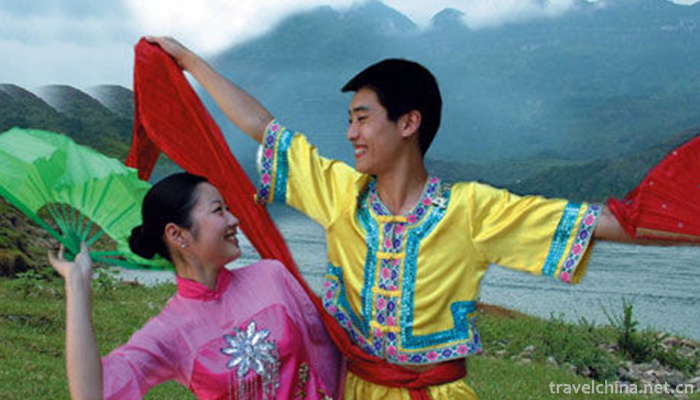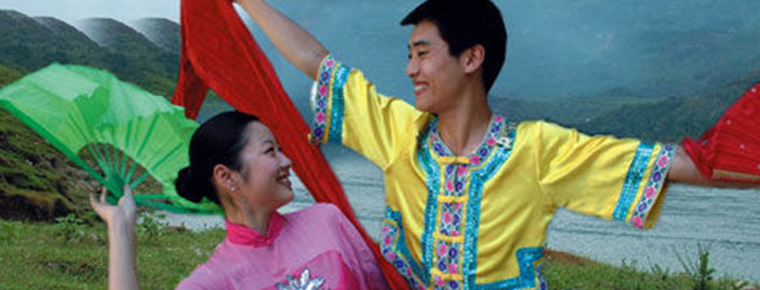Lantern Opera
Lantern Opera
Flower lantern opera is a kind of traditional opera widely popular in China. Its prominent feature is that the hands are inseparable from fans and handkerchiefs, singing and dancing, and singing and doing are closely integrated. Flower lantern opera, originating from Folk Lantern singing and dancing, is a form of local opera formed in the late Qing Dynasty and the early Republic of China. In the process of popularity, different singing and performing styles are formed due to the influence of local dialects, folk songs and customs.
Brief history of drama
Flower lantern opera is widely popular in Jiangxi, Guangxi, Zhejiang, Hunan, Hubei, Yunnan, Guizhou, Chongqing, Sichuan and Shaanxi provinces in southern China. It is a form of opera art and belongs to traditional folk minor drama. The lantern opera is developed from lantern singing and dancing, commonly known as lantern opera, flower opera and so on. The earliest record of flower lantern art is the Zhili State Chronicle of Pingyue in the early years of the Kangxi reign of the Qing Dynasty (1663). It says that "the weak boys in the city are decorated with women's clothes, group of jacquard lanterns, pretending to be tea pickers, they use lanterns as tea baskets and sing the song of"Tea Picking in December"around the courtyard everywhere. Here is Zunyi's lamp-playing custom. The custom of playing lanterns in Guiyang is found in Tian Wen's Qian Shu in Kangxi. Among them, the unknown Spring Lantern Ci has the sentences of "singing tea with a bun of flower bells" and "walking with lanterns in strings". Write about the scenes of Baina and Wumeng minorities playing lanterns during the Spring Festival in the suburbs of Guiyang. In the poem, "Tea Picking" is "Tea Picking Song in December".
The state attaches great importance to the protection of intangible cultural heritage. On May 20, 2006, lantern opera was approved by the State Council and listed in the first batch of national intangible cultural heritage list.
Inheritance significance
Since 2000, flower-lantern operas in various places have faced the same dilemma as other traditional opera arts. Theatre performances are decreasing day by day, theatre troupes are short of funds, new repertoires are difficult to arrange and perform, and the young generation of compilers and performers are short of successors. It is urgent to take measures to rescue and protect the local characteristic drama of flower-lantern opera .


-
1.sauteed tofu in hot and spicy sauce
sauteed tofu in hot and spicy sauce is one of the traditional dishes in Sichuan
Time 2018-10-12 -
2.Mount Tai
Mount Tai, also known as Daishan, Daizhong, Daiyue, Dongyue, Taiyue, is located in the central part of Shandong Province, belonging to Tai'an City, stretching between Tai'an, Jinan, Zibo, with a total
Time 2018-10-28 -
3.Xiangsha Bay Scenic Spot in Dalat Banner Ordos
Xiangsha Bay was opened as a tourist attraction in January 1984, listed as a national line scenic spot by the National Tourism Administration in 1991
Time 2018-11-29 -
4.Yin Ruins Scenic Area (Yin xu)
Yin Ruins, formerly known as "Northern Mongolia" , is the ruins of the capital city in the late Shang Dynasty of China, located in Anyang City, Henan Province
Time 2018-12-09 -
5.Tanggu Dagukou Battery Site Museum
Dagukou Battery Site Museum is located on both sides of the Haihe River estuary in the southeast of Tanggu, Tianjin Binhai New Area. It is a national education and youth education
Time 2019-02-13 -
6.Bai nationality tiedyeing skills
Bai tie-dyeing technology, the local traditional textile dyeing technology in Dali City, Yunnan Province, is one of the national intangible cultural heritage.
Time 2019-04-03 -
7.Luochuans drums
Luochuan Yigu, a traditional dance in Luochuan County, Shaanxi Province, is one of the national intangible cultural heritage.
Time 2019-05-15 -
8.Pingyao Pushing Lacquerware Decoration Techniques
Pingyao polishing lacquerware decoration technology originated in Pingyao County, central Shanxi Province, and spread to the vast northern region. Lacquerware made with this technique has been well kn
Time 2019-06-09 -
9.Water Encouragement
Water drum dance is a kind of popular dance spread between the De'ang and Miao nationalities. It combines water, drum and dance to worship ancestors, pray for good weather and peace in villages. Howev
Time 2019-06-15 -
10.Wudang Mountain Palace Viewing Taoist Music
Wudang Mountain Palace Taoist Music is the product of the combination of excellent traditional folk culture in Qinba area of Hubei Province and court music from Tang Dynasty to Ming Dynasty. It is the
Time 2019-06-30 -
11.Beijing Sport Univerrsity
Beijing Sports University was founded in 1953, formerly known as the Central College of Physical Education, renamed Beijing Sports College in 1956 and Beijing Sports University in 1993. It is a nation
Time 2019-09-06 -
12.Education in Panzhihua
By the end of 2018, Panzhihua had 2 ordinary colleges and universities, 56 ordinary secondary schools, 7 secondary professional schools, 60 primary schools and 194 kindergartens. There are 26617 students in Colleges and universities, 72372 students in secondary schools
Time 2020-12-14